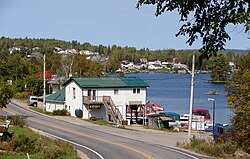Kipawa, Quebec
Kipawa | |
|---|---|
 | |
 Location within Témiscamingue RCM | |
| Coordinates: 46°47′N 78°59′W / 46.783°N 78.983°W[1] | |
| Country | Canada |
| Province | Quebec |
| Region | Abitibi-Témiscamingue |
| RCM | Témiscamingue |
| Settled | 1870s |
| Constituted | January 1, 1985 |
| Government | |
| • Mayor | Norman Young |
| • Federal riding | Abitibi—Témiscamingue |
| • Prov. riding | Rouyn-Noranda–Témiscamingue |
| Area | |
• Total | 46.84 km2 (18.09 sq mi) |
| • Land | 35.58 km2 (13.74 sq mi) |
| Population (2021)[3] | |
• Total | 446 |
| • Density | 12.5/km2 (32/sq mi) |
| • Pop (2016–21) | |
| • Dwellings | 325 |
| Time zone | UTC−5 (EST) |
| • Summer (DST) | UTC−4 (EDT) |
| Postal code(s) | |
| Area code | 819 |
| Highways | No major routes |
| Website | www |
Kipawa is a village and municipality in western Quebec, Canada, in the Témiscamingue Regional County Municipality. It is located at the south end of Lake Kipawa, adjacent to the Kebaowek Reserve. In addition to the community of Kipawa itself located on the namesake lake, the municipality also includes the community of Tee Lake (originally called Gendreau at the end of the 19th century),[4] and surrounds the Indian Reserve of Kebaowek.
Kipawa is a variant of the Algonquin word Kebaowek which means "closed water", referring to the many closed-off bays and passages of Lake Kipawa.[1] Another theory claims that it means "getting off" or "disembarkation", or the location where one can pick up supplies or trade.[5]
Its main employer is the Commonwealth Plywood Company.
History
[edit]The land including and surrounding Lake Kipawa and Kipawa Village has been inhabited for centuries by the Algonquin people. The first Europeans to come into the Kipawa basin were fur traders and missionaries.
The area was logged in the second half of the 19th century, and the railroad was built in the 1880s, with its stations known as Kipawa Station et Kipawa Junction.[1]
On January 1, 1985, the Municipality of Kipawa was created out of previously unincorporated area.[6]
Demographics
[edit]In the 2021 Census of Population conducted by Statistics Canada, Kipawa had a population of 446 living in 214 of its 325 total private dwellings, a change of -10.6% from its 2016 population of 499. With a land area of 35.58 km2 (13.74 sq mi), it had a population density of 12.5/km2 (32.5/sq mi) in 2021.[3]
| 2021 | 2016 | 2011 | |
|---|---|---|---|
| Population | 446 (-10.6% from 2016) | 516 (8.9% from 2011) | 474 (-16.1% from 2006) |
| Land area | 35.58 km2 (13.74 sq mi) | 36.59 km2 (14.13 sq mi) | 36.76 km2 (14.19 sq mi) |
| Population density | 12.5/km2 (32/sq mi) | 14.1/km2 (37/sq mi) | 12.9/km2 (33/sq mi) |
| Median age | 54.4 (M: 55.6, F: 53.2) | 49.5 (M: 50.2, F: 48.5) | 45.9 (M: 45.8, F: 46) |
| Private dwellings | 325 (total) 214 (occupied) | 339 (total) 229 (occupied) | 276 (total) 208 (occupied) |
| Median household income | $80,000 | $74,624 | $68,984 |
|
| ||||||||||||||||||||||||||||||
| Population figures based on revised counts. Source: Statistics Canada[10] | |||||||||||||||||||||||||||||||
Mother tongue (2021):[3]
- English as first language: 42.7%
- French as first language: 52.8%
- English and French as first language: 3.4%
- Other as first language: 1.1%
See also
[edit]References
[edit]- ^ a b c "Banque de noms de lieux du Québec: Reference number 141531". toponymie.gouv.qc.ca (in French). Commission de toponymie du Québec.
- ^ a b "Répertoire des municipalités: Geographic code 85010". www.mamh.gouv.qc.ca (in French). Ministère des Affaires municipales et de l'Habitation. Retrieved 30 November 2023.
- ^ a b c d "Kipawa census profile". 2021 Census data. Statistics Canada. Retrieved 2022-04-29.
- ^ "Banque de noms de lieux du Québec: Tee Lake". toponymie.gouv.qc.ca (in French). Commission de toponymie du Québec. Retrieved 2023-11-30.
- ^ "Interview with Mike McKenzie and Francis Robinson". Témiscaming 1921-1996: nos racines, notre histoire (in French). Book Committee: Louise Forget, Yolande Dumas, Julienne Cécire, Thérese Gélineau, Ken Collins, Ross Sparling, Philippe Barette, Shirley McCullock, Marjorie Brown, Linda Lamarhe, Pierre Bérubé, Gerry Jones, Peter McCulloch, Lois Lynn. Témiscaming?: s.n. 1996. p. 358. ISBN 9782980420603. OCLC 936856576.
{{cite book}}: CS1 maint: others (link) - ^ "Répertoire des entités géopolitiques: Kipawa (municipalité) 1.1.1985 - ..." www.mairesduquebec.com. Institut généalogique Drouin. Retrieved 28 November 2023.
- ^ "2021 Community Profiles". 2021 Canadian census. Statistics Canada. February 4, 2022. Retrieved 2023-11-28.
- ^ "2016 Community Profiles". 2016 Canadian census. Statistics Canada. August 12, 2021. Retrieved 2024-01-15.
- ^ "2011 Community Profiles". 2011 Canadian census. Statistics Canada. March 21, 2019. Retrieved 2024-01-15.
- ^ 1996, 2001, 2006, 2011, 2016, 2021 census
Further reading
[edit]- Kermot A. Moore, Kipawa: Portrait of a People. Cobalt, Ontario: Highway Book Shop, 1982. ISBN 0889542430.
External links
[edit]- Official website

- "Kipawa History". Kipawa.com : A Hunting, Fishing, & Travel Guide for the Kipawa Lake Region. Retrieved 11 February 2012.

